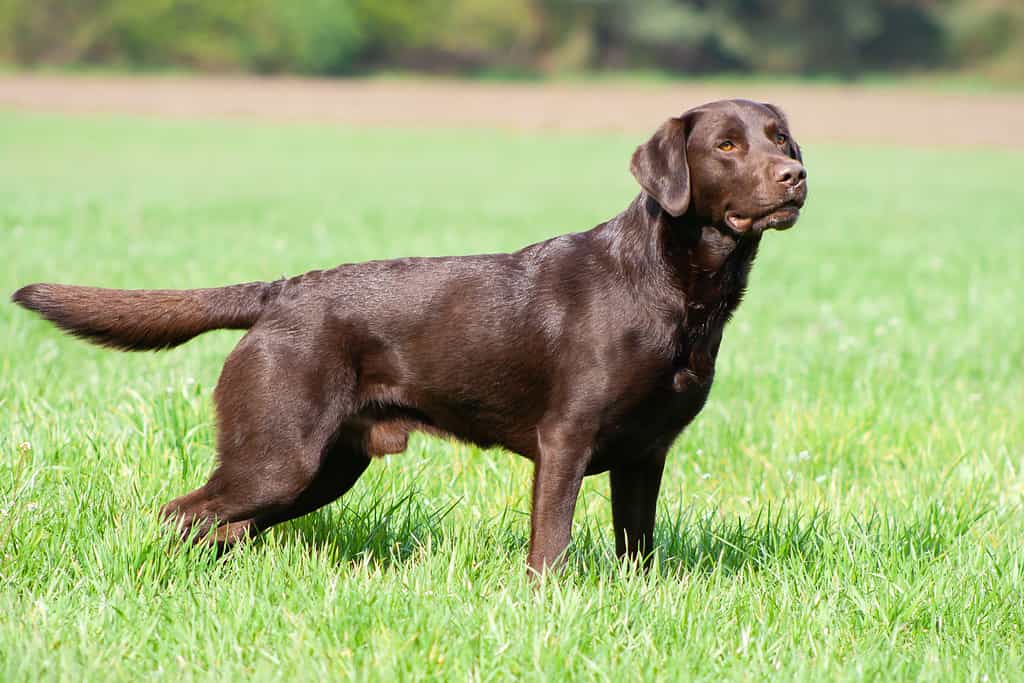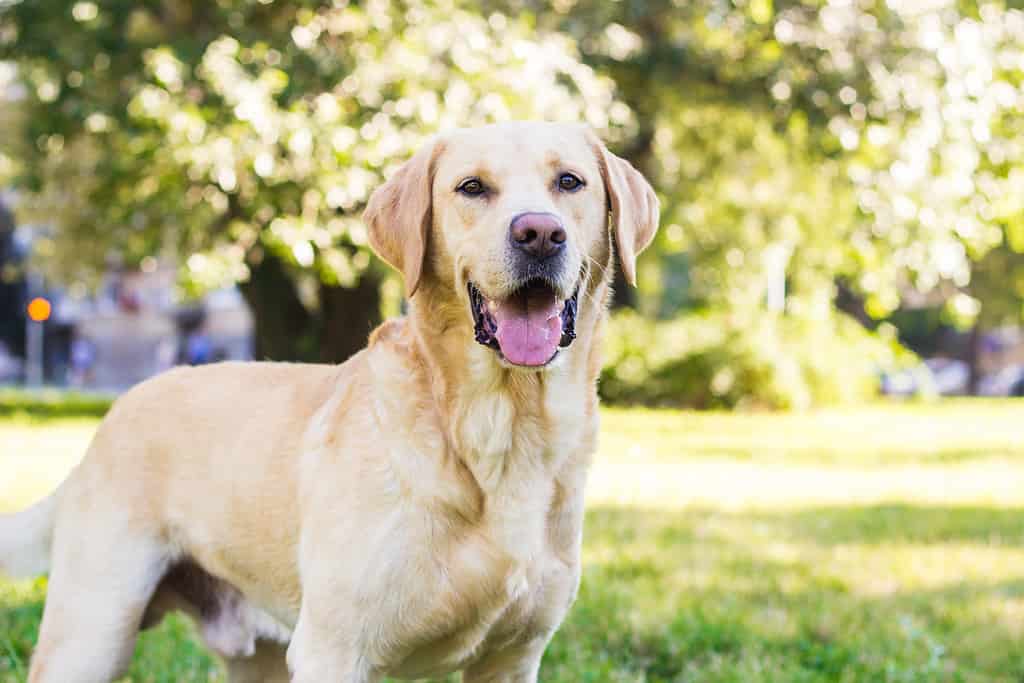According to the American Kennel Club, the Labrador Retriever has been the most popular dog in the United States for 31 years straight! Just this past year, 2022, did a new dog take over the top spot. French Bulldogs may hold that spot now, but Labrador Retrievers have a long history of being amazing hunting dogs, family pets, and service dogs. But it might surprise you to find out what Labrador Retrievers were originally bred for. Their history is a story of combining the best qualities of two types of dogs to form what we know today as the classic Lab. Read on to find out what were Labrador retrievers bred for. In addition, learn about their original role, jobs, history, and more!
What is a Labrador Retriever?

©REN Photography/Shutterstock.com
You probably know what a Labrador Retriever is but let’s look at some stats about this popular breed. Labs are medium to large dogs in the “Sporting Dog” group. They range in size from 21.5-24.5 inches at the shoulder. Females may be closer to 55 pounds whereas males can get up to 80 pounds. They typically have a short coat that is universal in color such as all black, all yellow, or all chocolate. In addition, Labrador Retrievers are known to be friendly, easy to train, and eager to please.
What were Labrador Retrievers Bred for?
Labrador Retrievers were bred to be hunting dogs. The Earl of Malmesbury watched St. John’s water dogs perform incredible diving and retrieving acts in Poole, England. The St. John’s dogs were brought over to England by fishermen from Newfoundland of Canada. He admired the dogs’ retrieving abilities and seemingly waterproof coats. He hoped these dogs would be easy to train so he could use them as duck-hunting dogs. This is when he started a breeding program for what originally was called the “Labrador Dog” (named after the Labrador region of Canada which is northwest of Newfoundland.)
What was the Original Role of the Labrador Retriever?
The original role of the Labrador Retriever was to help fishermen in Newfoundland, Canada. The St. John’s water dog, as they were called, would work in the fisheries and retrieve fish that slipped through the nets, help haul nets, and would even retrieve wayward hats that blew off of fishermen’s heads. Records of the first St. John’s dogs date back to the early 19th century. Therefore, you can see how these early fishing skills transferred over well to the retrieving the Labrador is known for today.
What Jobs Have Labrador Retrievers Had?

©sanjagrujic/Shutterstock.com
Labrador Retrievers started out working in fisheries, retrieving fish and helping with long lines and nets. When Newfoundlanders brought their St. John water dogs over to England, the dogs were bred with hunting dogs. This new breed was bred to work as duck hunting dogs. The British were looking for a dog that was trainable and would not be skittish around the new guns that could shoot multiple shots at a time. They needed a dog that could retrieve multiple birds now that they could take down more ducks in a single hunt.
What Jobs Do Labrador Retrievers Have Today?
Today, Labrador Retrievers are still incredible hunting companions and reliable gun dogs. They work in the fields retrieving games in a wide range of conditions and seem to enjoy the work with their owners. Their trainability has been recognized over the years and Labs have been used in many specific jobs including:
- Service dogs
- Guide dogs
- Customs task force
- Search and rescue dogs
- Scenting dogs for the military
- Arson task force
- Therapy dogs
What is the History Behind the Labrador Retriever Breed?
The history behind the Labrador Retriever dates back to the early 19th century. Their origin started in Newfoundland, Canada. At the time, fishermen from England, Spain, France, and Portugal came over to Canada to search for a new market for fishing. The dogs from these different areas got together in their new land and new breeds were formed including the water-loving St. John’s water dog. These dogs were recognized to be great in the water and easy to train to retrieve fish.
When the early fishermen went back home, they brought the new breed with them. Some of the fishermen started to show off their dog’s skills in Poole, England. This is where the Earl of Malmesbury first saw the breed and knew he wanted to start a breeding program to combine the traits of the St. John’s water dog with the English hunting dogs. Later, in the 1880s, the Duke of Buccleuch and Earl of Home in Scotland played an important role to help maintain the early bloodlines of what we now know as the Labrador Retriever. By 1903, the Labrador was recognized by the Kennel Club in England. Additionally, by 1917, the Labrador Retriever was first registered by the American Kennel Club.
What is the Difference Between American Labs and British Labs?

©Jagodka/Shutterstock.com
Today, you will find some similarities and some differences between the American Labs and British (or English) Labs. American Labs are a bit taller, allowing heights up to 24.5 inches vs 22.5 for the British, and a tad slimmer. In addition, British labs have a fuller body and chest. Amercian labs have a more athletic build with slightly longer legs and a longer snout. American labs typically are more active and have a stronger drive than the more calm British Labs. Both types have the same water-resistant coat and unique “otter-like tail”. They also share the same coloration of the majority being all black; yellow being the second most abundant color and the recessive chocolate brown being third.
What Were Labradoodles Bred for?
The now popular Labradoodle was originally bred to be a hypoallergenic guide dog. Wally Conron started the first purposeful crossbreeding between Standard Poodles and Labrador Retrievers in 1989. He ran the Royal Guide Dogs Association of Australia and wanted a breed that had the trainability of the Labrador, but would also be allergy-free. The resulting Labradoodle started a trend of breeding “doodles. These dogs are popular because they shed less, are more hypoallergenic, and are still friendly, easily trainable dogs. Labradoodles continue to be trained as guide dogs but are also wonderful family pets.
The post What Were Labrador Retrievers (Labs) Bred For? Original Role, Jobs, History, and More appeared first on AZ Animals.
from Animal News, Facts, Rankings, and More! - AZ Animals https://ift.tt/g2dpK53